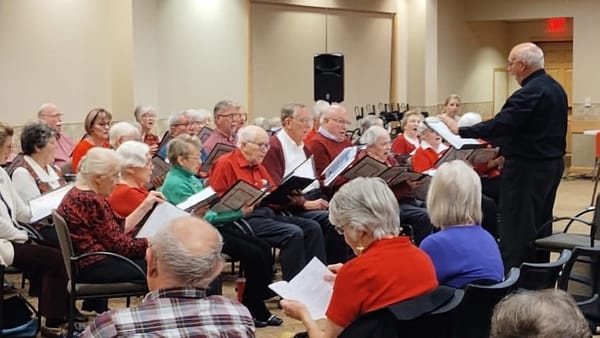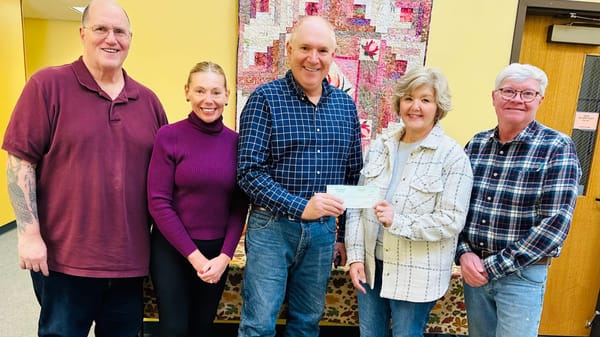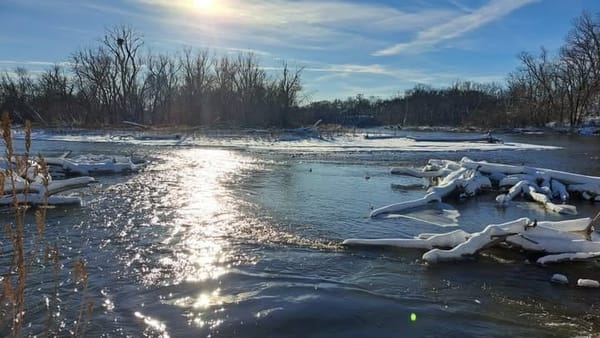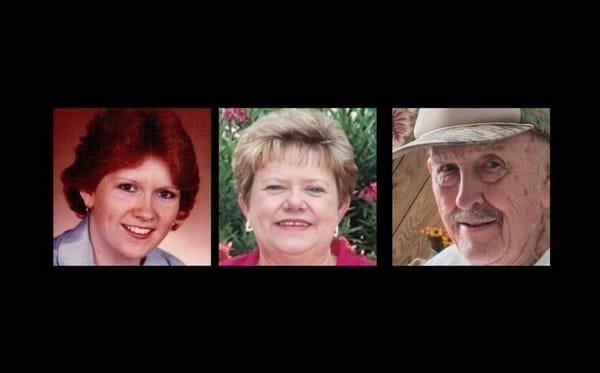Talcott family reunion: 189 years of Rockton history
After Stephen Mack, Rockton's first permanent settlers were Capt. William Talcott and his son Thomas B. Talcott.

Rockton recently welcomed the Talcott family who reunited in Rockton on Saturday, Aug, 3, 2024. They started the day with a visit to the Rockton Township Historical Society (RTHS) that morning. This event was one of many that the family celebrated from Aug. 1-4, 2024.
Among other achievements, the Talcott family helped to found Rockton, establish the Talcott Free Library and the Old Stone Church, enable water power, and create the cemetery.
RTHS President Marilyn Mohring opened by telling Talcott family members, “Welcome to your hometown,” adding “In just four weeks the Mack family will be having a reunion.” Though Stephen Mack's settlement was the first in Winnebago County, the Talcott's settlement, on the other side of the river, outlasted it.
Rockton Village trustee Jodi May presented the Talcott family with a special certificate on behalf of the Village of Rockton, proclaiming August 3 as Talcott Family Heritage Day.
May said, “Thank you to your family for everything they have done for our little village.
After being presented with the proclamation, Dexter Talcott, the head of the Talcott Family Association, gifted a special memento to Mohring.
During the reunion dates, the Talcotts went to the Old Stone Church, Talcott Library, the race, and the Rockton Township Cemetery to see family markers. In Rockford they visited the Talcott building, in the 300 block of W. State Street, and Midway Village Museum where Adeline Talcott’s wedding dress is on display.
RTHS President Marilyn Mohring gave a presentation on the history of the Talcott family, who were instrumental and highly influential in shaping Rockton.
Traveling to Rockton
The first permanent white settlers in Rockton beside Stephen Mack were Capt. William Talcott and his son Thomas B. Talcott.
In June 1835 they traveled west from Rome NY, coming all the way by horse and wagon with the plan of reaching Milwaukee, WI.
Thomas’s journal of July 10, 1835 says, "Left our Indian tavern this morning after breakfast, Came to Rock River south of Milwaukee, after a few miles our horse got mired and we had to loosen him from the wagon." On July 16 they found their horse after searching for it, but it was in poor condition. They headed toward Chicago walking all the way.

On July 17 they bought another horse to go the Rock River on horseback.
On July 22 they started toward the Rock River. On July 25 they saw several Indians. One, a Potawatomi, said there were white folks within a few miles. One motioned to follow him, leading the men to Stephen Mack’s Indian trading establishment.
They found they were on the bank of the Rock River, about two miles below the mouth of Pecatonica, six miles south of Wisconsin territory, at a settlement then known as Pecatonic.
The Talcotts stayed with Stephen Mack while making their claims. But disagreements later caused the Talcotts to settle across the river, at the current site of Rockton.
Mohring showed a slide of the first Talcott cabin.
The Talcott Family
By October 1835, more of the family had arrived in Rockton, including Thomas’s brother Henry Walter Talcott. With his wife and children, they lived in a large stone home at the corner of Chapel and Blackhawk, then Washington Street.

Henry was engaged in various industries with his brothers.
The father, Capt. William Talcott, went back east to settle his business before moving back with his family in 1837. His children included Sylvester, Wait, Prudence, and others.
Sylvester Talcott had been keeping a store in Horseheads NY until he came west in 1836. He was elected as a Justice of the Peace, performing the first wedding in town in 1837.
‘Deacon’ Wait Talcott came to Rockton in the fall of 1838 with his wife and daughter.
His daughter Adaline Talcott married Ralph Emerson, presumably in the Talcott home in Rockton. She taught school in Rockton before they moved to Rockford. They were philanthropists and authors of the book "Personal Recollections of Lincoln."
Adaline’s brother William Ariel Talcott worked with the Talcott Implement Company and Emerson-Brantingham Company with his brother-in-law.
Prudence Hubbard Talcott was the youngest of ten children of Captain William and Dorothy Blish Talcott, coming to Rockton in 1837 with her parents and several other family members. She had two stepsons.
A photo featured the Hersey Farm that sat between Rockton and Beloit, on the east side of the Rock River. Clark School was near the farm.
During the Civil War, Sylvester Talcott was not required by law to perform military service, but paid John W. Whipple to serve in his stead in the Union army, and received a certificate saying, “He is in accordance with the foregoing order entitled to this official acknowledgement of his disinterested patriotism and public spirit.”
Sylvester was elected as the first Township Supervisor in 1850. He was also a trustee in the Congregational Church for several years.
Old Stone Church
Captain William Talcott is called the “father of Rockton.” He was instrumental in forming the Congregational Church, now known as the Old Stone Church in Rockton in 1838. In 1837 he asked the Rev. Wm. Adams to come to Rockton to organize the church. There were 14 original members of the Congregational Church, nicknamed the Old Stone Church, five of which were Talcotts.
The building was completed in 1850 at a cost of $5,000. In 1854 Talcott donated the bell at a cost of $700 with a weight of 1400 lbs.

In 1935 the church was deemed to have architectural merit worthy of preservation by the Historical American Building Survey. Drawings and photographs were recorded and placed in the Library of Congress.
Waterpower and Building the Race
Perhaps William Talcott’s greatest contribution to the area was the development of waterpower for industry by building the mill race. He had realized that the drop along the Rock River at the race had a greater fall than any on the river. Its flow of water was 12,000 inches with a fall of nine feet. The entire mill race was dug by hand, with dirt hauled away by horse and wagon. A sawmill and a grist mill was completed in 1838.

Talcott Library
Talcott Free Library began in 1875 when a public Library Association was organized in Rockton where each person had to pay to use the collection.
Thirteen years later, in June of 1888, the Honorable Wait A. Talcott donated a building to the Rockton Township to be used as a library. The original building was constructed in 1854 as a feed and grain store.
His donation came on the condition that the town would incorporate under the laws of Illinois and vote to establish a tax to support the library.

Wait’s son William paid for the repair of the building to become a library including a new roof. His brother Thomas Blish Talcott donated a nucleus of books and W.W. Austin installed electric lights. It was dedicated on Aug. 22, 1889 and named Talcott Free Library because the public no longer had to pay to use the collection.
Rockton Township Cemetery
Rockton Township Cemetery on 10 acres of land was purchased by the village from Wait Talcott at a cost of $870 with surveying costs of $45.91.
The cemetery holds a memorial to Thomas B. Talcott, his wife Sophia Willard Talcott and their only child, a son who died when three days old sits in the cemetery.

Thomas was elected as the first county commissioner in 1836, holding that office for five years. He was also among the group of men who organized the County of Winnebago in August 1836. The original county area included present Boone County and Winnebago plus two tiers of townships from Stephenson County. Later, Winnebago County was reduced in size to the present 16 townships.
Business Ventures
Wait Talcott and his brother Sylvester formed a co-partnership with John H. Manny, Jessie Blinn and Ralph Emerson to manufacture the celebrated Manny Reaper which became one of the largest manufacturing industries in Rockford.
Wait was also a collector of internal revenue for this congressional district under President Abraham Lincoln. He was part of Lincoln's funeral procession in Washington DC.
He also was one of the original incorporators of Beloit College and the Rockford Female Seminary, now Rockford University, where he was a member of the Board of Trustees. In 1854 he was elected as a state senator. He represented Boone, Ogle and Carroll Counties for four years. During his term he secured a charter for a railroad from Rockford to Rockton and on to the Stateline. Wait held large contracts for building the Racine and Mississippi railroad from Rockton to Freeport.
Accidental death
In 1870 the news reported of the accidental death of Henry W. Talcott on Dec. 9 after being thrown from his buggy. He was found four miles from the scene of the accident in Roscoe.
The Talcott family left an enormous impact on the development of Rockton and surrounding communities leaving a legacy with great benefits for everyone.





